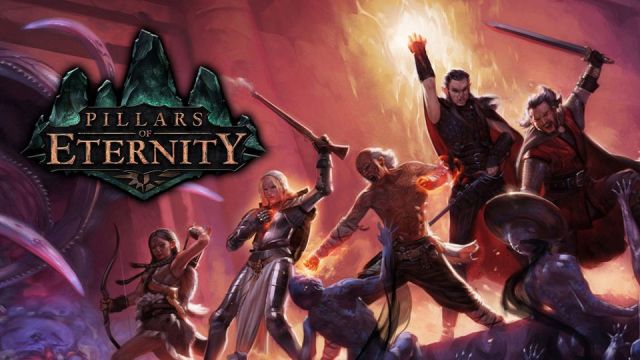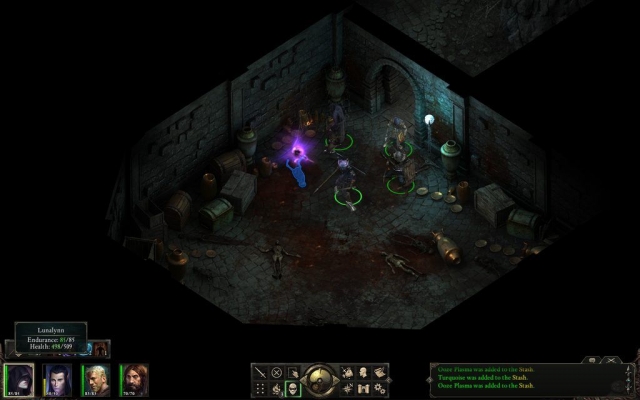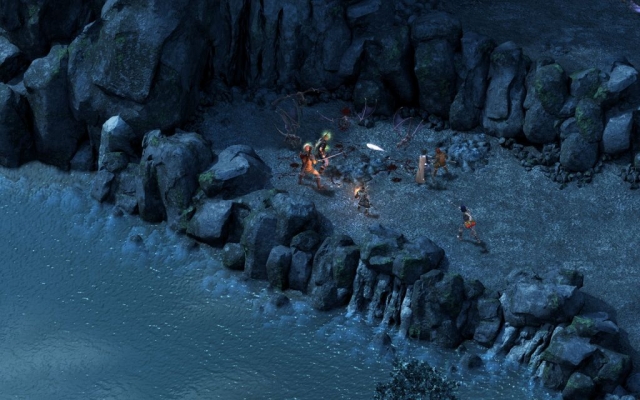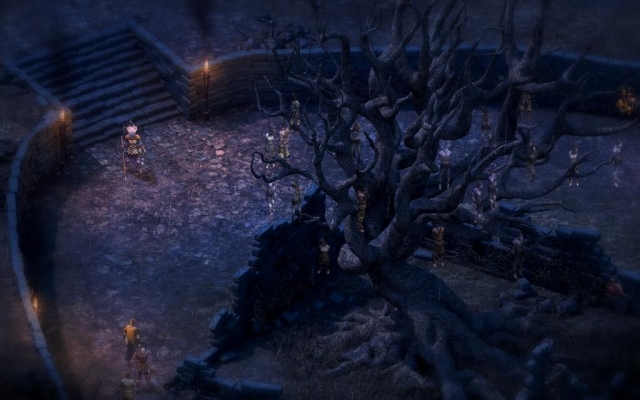Pillars of Eternity

The Good: Really, really intricate RPG with fully-fleshed world. Unique spin on earning XP.
The Bad: Spastic combat. Some character types seem like evolutionary dead ends.
The Ugly: Be prepared to read, A LOT (to be fair, some gamers don’t see this as an ugly).
I’m going to start this review with two seemingly disparate facts, but if you stick with me for just a moment, like all my insights this one will prove to be brilliant.
-
1) In the Adventures of Tom Sawyer, a novel written by Mark Twain in 1876, the titular Tom Sawyer is given the chore of painting a fence. He convinces his friends that the job is so important and so satisfying that they pay him for the opportunity to paint some of the fence.
2) In 1981, while many of you were little more than glimmers in your parents’ eyes, I was playing Ultima (later to be known as Ultima I, but we didn’t know there would be more of them at the time) on an Apple II. It was a top down RPG, and what seemed like an amazing thing was that you could wander into a town and walk up to absolutely any character appearing in the streets and talk to them. Sure, all they had to say was “Good Morning!” or “Welcome!” or occasionally “Hic!” (the town drunk), but just having those NPC characters at all, or towns for that matter, was pretty revolutionary.
These two disparate facts are more pertinent to Pillars of Eternity than you might imagine, because what the folks at Obsidian did was Kickstarter the funding for PoE, and they got 77,000 backers (I didn’t know that on my own – the opening graphics of the game told me that), and as a reward the very highest dollar amount supporters got to create, in a very Tom Sawyer-esque manner, content for the game. For $1,000 you could create an NPC for the game, or an epic weapon, piece of armor, or artifact. For $5,000 you get to create a tavern or inn in world, or name and design an enemy adventuring company. And for $10,000, more than a minimum wage worker earns in six months, you got to paint a fence at Obsidian’s corporate headquarters! I’m kidding, of course. For $10,000 you got to attend a PoE launch party at Obsidian where, though they don’t specifically state that fence painting wasn’t involved, they probably didn’t require any fence painting.
The result is that this world has hundreds of little touches (not 77,000 – not everyone had $1,000 to burn), that make the world of PoE feel incredibly complete, more than any other game in my considerable gaming memory, and Obsidian got to crowdsource a fair chunk of their world. The downside is that most of these touches come in the form of text, paragraphs and paragraphs of text, and even as a reader, all that text gets exhausting. It also has a kind of disjointedness that you would expect when pieces of a narrative are written by hundreds of different authors. The resulting world of PoE is complex, in a pleasant way, with a thousand years of history and lore, warring nations and personalities and places and events of historical significance. The game maintains an encyclopedia for you as you learn things (more reading), but PoE is the first game I’ve kept actual written notes about (there’s an electronic notepad built into the game but I found that less convenient) in I can’t remember how long.
That kind of depth clearly isn’t for everyone. I suspect many gamers will find it too plodding, too much reading and not enough action. PoE harkens back to the days of Baldur’s Gate and NWN, and before that, days of pen and pencil D&D where the game was more focused on the story than the combat. That said, this is clearly a video game, and a chunk of the time you’ll be in combat (or sneaking past it), and I think the combat system is a little bit of a mess.
While wandering around the map, you occasionally encounter enemies. The game pauses at that point (actually, it doesn’t have to pause at that point – I’ll go into that more in a moment) and combat begins. You don’t go to a new map or an arena or anything – combat takes place right where you are, and you can use the terrain and features of the dungeon or whatever to make choke points and limit the enemies’ ability to surround and beat on you. Planning the formation and location of your party prior to engaging can be a big plus. Combat takes place in real time, but it’s complicated. My own party had five members at one time, and I have no idea what the limit to that is. Each of them has special skills and spells and attacks that are accessed through little action bars – you have to pause combat and pause often to be effective. The game realizes this, and gives you an entire page of options allowing you to set the conditions under which combat is paused automatically. But you know what? Even with that entire page of options, I never found a way to conduct combat smoothly. Different characters have different attack rates, and I found myself constantly pausing combat manually (space bar) to issue new orders, and in a tough combat events can turn against you much more quickly than you can respond. Stacked up against high-action, low-strategy combat (Diablo, Torchlight) and low-action, high-strategy combat (Blackguards, XCOM), PoE resides in a kind of pausable high-action, high-strategy realm that I found really hard to get a hang of. I don’t recall either Baldur or NWN having this problem.
And while I’m on the topic of combat, killing things doesn’t get you XP. You read that right. I’m not exactly sure how it works, but it seems like the first few kills of a beastie does net some XP, but progressively less and less, so that killing your 100th wolf doesn’t buy you anything unless you have a yen for wolf pelts. XP is gained primarily by completing quests and accomplishing things. It’s a bold move, awarding strategies other than the common RPG approach of wiping out all the fauna. It’s not going to suddenly turn the game into an isometric version of Thief – for one the dungeons are not really large enough to allow you to sneak by everyone regardless of your stealth skill – but you don’t have to meet every immovable object with an irresistible force.
Some of the typical old-school RPG wrinkles plague this game as well. Mages (the game has three or four flavors of them) are a little fragile to start out. Rangers, bricks and the like make for a much easier start. Magic users can cast only a certain number of spells before needing rest, and once their spells are gone they’re more or less useless in combat. Camping uses, I don’t know, disposable sleeping bags or something, and you can only carry four of them at any given time, so you end up spending a lot of time backing out of dungeons and running to the nearest inn to rest. Crafting is really rudimentary amounting to nothing more than combining ingredients you find against some fixed recipes. Enchanting armor and weapons falls into the same recipe rhythm.
Pillars of Eternity represents a type of RPG adventuring that has gotten kind of niche in the wake of changing game tastes. 77,000 people wanted to relive their glory days of Baldur’s Gate and paid for the luxury of doing so. The result I think is a remarkable recreation of that flavor of gaming. Some elements remain a little rough, but the folks at Obsidian, this isn’t their first rodeo, and I expect they’ll keep an eye on their forums and make some patches and get it right. If you miss this kind of gaming, PoE should scratch that itch nicely.
Reviewed By: Phil Soletsky
Publisher: Paradox Interactive
Rating: 85%
——————————————————————————–
This review is based on a digital copy of Pillars of Eternity for the PC provided by Paradox Interactive.
 Game Over Online
Game Over Online











